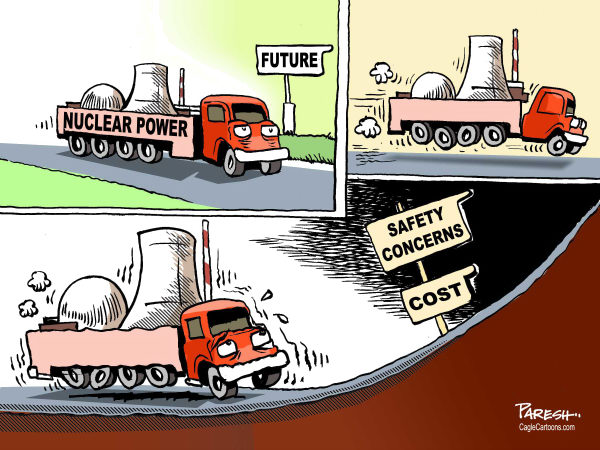What This State Needs Is a Good FIT
Doing Without Nuclear Power

It’s not been a good year for nuclear power. A federal court recently found that local-storage solutions for nuclear waste – it is currently kept at each power plant where the waste is produced – have not been shown to be safe. The Nuclear Regulatory Commission, the federal agency that regulates nuclear power, must complete a full review or explain why one is not required.
Perhaps more seriously, the San Onofre nuclear plant (SONGS), owned and operated jointly by Southern California Edison and San Diego Gas & Electric, has been shut down since January due to unexpected and unexplained erosion of numerous pipes in its power generators.

It is unclear when SONGS will be re-started – if ever. The power generators were almost new, having just been replaced in 2010 at a cost of $680 million, charged directly to us, the electricity ratepayers of California. This expense came on top of the many billions required for construction and other expenses.
Last year, of course, Japan’s unfortunate accidents with its Fukushima nuclear plants illustrated the potential harm that nuclear plants can wreak – and the inability of even the world’s best engineers to plan for all possible eventualities. As I wrote in a piece earlier this year, a number of countries are now phasing out nuclear power entirely as a consequence of Fukushima.
California is now considering how to respond to the SONGS shutdown. Do we need more power plants, or at least better local capacity, and if so what kinds of power plants should be built to replace SONGS? Should the Diablo Canyon nuclear plant, located near San Luis Obispo and owned and operated by PG&E, also be shut down due to lingering safety concerns related to local earthquake faults?
There are many questions and no easy answers. I’ve recommended previously that California agencies, as a first step, analyze how California could in theory cope without nuclear power. The California Independent System Operator (CAISO) has completed detailed modeling of various scenarios, in order to inform the California Public Utilities Commission long-term planning process. These scenarios don’t currently include a nuclear-phaseout scenario but they should. This new scenario planning would be the first responsible step to dealing with the SONGS issues and broader nuclear safety issues.
The previous detailed state-wide modeling completed by CAISO for the CPUC’s long-term planning found that we have a huge surplus of power state-wide, and we will very likely maintain this surplus through 2020 even as we reach 33% renewables. It seems, given this huge state-wide surplus, that we could probably phase out nuclear over the next decade without much difficulty, at least with respect to keeping the lights on.
However – and this is an important “however” – CAISO recently completed a survey of the backup power available in the SONGS area and concluded that there may be some cause for concern with respect to locally available backup capacity: “The absence of the San Onofre nuclear plant does not create system-wide issues but does create local reliability issues because of transmission constraints that limit imports into the Los Angeles Basin and San Diego areas.” The issue of local power needs is far less clear than the state-wide discussion.
Some policymakers and advocates are currently considering the merits of investing heavily in transmission resources, in order to ensure that the power surplus available in California more generally can reach the areas where it’s needed, like the SONGS area. However, a very important part of this conversation must be consideration of non-transmission alternatives such as local power options, known as “wholesale distributed generation,” demand response, and energy efficiency. Wholesale distributed generation (WDG) is defined as renewable energy generated close to load.
Numerous examples support the ability of WDG to come online quickly and massively – with the right policies in place. California itself has demonstrated this clearly, back in the 1980s and 1990s, during which time we added over 10,000 megawatts of new renewable energy generation from geothermal, wind, biomass, hydro and solar power. This transformation of our power sector was made possible due to California’s robust, first-of-its-kind “feed-in tariff(FIT),” also known as CLEAN policies now, which stands for Clean Local Energy Available Now, part of an attempt to re-brand the name for better popular support. FITs provide a power purchase contract to any renewable energy developer meeting certain criteria. The contract provides a set payment over a set period. The major benefit of feed-in tariffs (FITs) is certainty, which every business knows is the key to successful markets.
California suspended the highly successful FIT program in the 1990s, but California’s experience with its FIT in the 1980s and 1990s led to jurisdictions like Germany, Italy, Spain, Portugal, China, the UK and dozens of other countries adopting their own robust FITs. FITs are now the preferred policy mechanism around the world for bringing renewable generation online quickly and efficiently. Wisely implemented FITs can also be more cost-effective than alternative policies like auctions or tender systems because of the greater market certainty, and thus far lower risk to developers and financiers.
Along with the nuclear-phaseout-scenario planning mentioned above, California should enact a robust FIT sufficient to replace at least the capacity of SONGS. This will, among other things, ensure that our power grid is strengthened through large amounts of local capacity, in the SONGS power area and elsewhere around the state. A 5,000 megawatt statewide FIT program, with clear and certain pricing and expedited interconnection procedures, will achieve many additional benefits besides ensuring that local capacity requirements are met in the SONGS area.
FITs are not dead yet in California today, but they are dying – unless policymakers wake up to their potential. Attempts to revive our success in the 1980s and 1990s have entirely failed. The CPUC just issued a terrible decision implementing what was already a very weak FIT bill (SB 32), three years after this law was passed. D.12-05-035 weakens SB 32 to the point of undermining the law entirely.
The key problem is that the CPUC decision enacted an adjustable pricing mechanism that will ensure a “race to unviability.” This is the case because the price offered to developers will drop so quickly that developers will be heavily incentivized to accept contracts at unrealistically low prices. It’s probably best at this point to scrap the new program under D.12-05-035 entirely and go back to the drawing board with a new bill.
A bill to enact a robust and effective five gigawatt FIT should ensure stable and realistic prices for renewable energy projects 10 megawatts and below. This is a scale that can be built quickly around the state, if good FIT and interconnection policies are enacted. At the same time, ratepayers should be protected from higher prices than are justified through planned and transparent “degression” of prices, under which prices offered to developers fall steadily as capacity is taken up.
This is similar to the policies enacted by D.12-05-035, but the price adjustment mechanism adopted in that decision fails on the details of its implementation, primarily due to the fact that the program is far too small – it added only 15 megawatts to an already-existing but highly ineffective FIT program, for a total of only about 200 megawatts of new contracts state-wide – and the price adjustments occur far too quickly. These are problems that can easily be remedied with a new bill.
The recent events at SONGS have resulted, perhaps serendipitously, in what may be the smoothest path to a nuclear-free future for California. Historically, any discussion of shutting down nuclear plants has been highly contentious in large part because of the many jobs at stake. No major releases of radiation have apparently occurred at SONGS, so this has not to date constituted a major nuclear accident. It was averted before that happened. The shutdown also happened in a way that was completely independent of politics or policy; rather, the shutdown occurred due to bad engineering. Perhaps most importantly, if SONGS is shut down permanently, it is almost a certainty that the many Southern California Edison and San Diego Gas and Electric employees at SONGS will be re-deployed elsewhere within those companies, and many will probably continue to work at SONGS as it is de-commissioned – a process that can take a decade or more.
In sum, California is looking at a future where nuclear power may be phased out involuntarily, in part or wholly, in the next few years. At the very least, we need to be responsibly planning for a potential nuclear-free future. And at the same time, we should enact a robust and effective feed-in tariff to strengthen our grid state-wide, while also adding numerous jobs, growing our economy, and reducing our greenhouse gas emissions.
The Los Angeles Times editorial board recently agreed with me, stating: “Now is the perfect time for Edison, and the state as a whole, to begin the planning for a non-nuclear future.”



